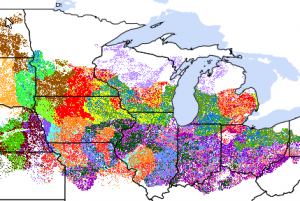
Areas with the same color indicate zones where the soil and climate are comparable – and consequently, where a fertilizer management product or tool could perform similarly.
NutrientStar, which assesses fertilizer management products and tools using field trials and in-depth scientific reviews, was a game changer for farmers. Prior to the launch of the program last year, there was no expert review program – no Carfax, no Consumer Reports – to help farmers determine what tools would work as advertised.
The only downside of the program was its limited utility. Farmers had no easy way to extrapolate results from the relatively few number of field trials performed thus far to their own locations.
Now, a new geospatial feature called the Technology Extrapolation Domain (TED) framework will make NutrientStar accessible to tens of thousands of additional farmers across the Corn Belt.
I like to think of it as NutrientStar on steroids. Read More










 Farmers have a host of competing priorities clamoring for their time, energy and money. Fortunately, they often have trusted advisers to help them make good decisions for their operations – including about conservation practices on the farm.
Farmers have a host of competing priorities clamoring for their time, energy and money. Fortunately, they often have trusted advisers to help them make good decisions for their operations – including about conservation practices on the farm. The corn and soybean fields that stretch for miles across the Midwest are quiet this time of year, mostly frozen surfaces waiting for the spring planting season.
The corn and soybean fields that stretch for miles across the Midwest are quiet this time of year, mostly frozen surfaces waiting for the spring planting season. A team of researchers spent seven years dissecting, analyzing and reporting on California’s nitrogen cycle, and the results are eye-opening.
A team of researchers spent seven years dissecting, analyzing and reporting on California’s nitrogen cycle, and the results are eye-opening.